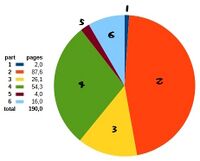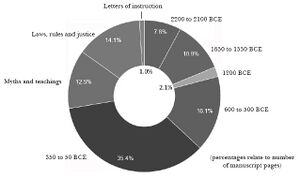Codex Oera Linda
(TO BE UPDATED)
Codex Oera Linda is the name used by Jan Ott for his printed and digital editions of the transliterated and translated Oera Linda manuscript. Copies of all manuscript pages were included in his 1st, 3rd and 4th edition, with line numbers. He also uses the name to refer to the manuscript itself, instead of Oera Linda Book.
Sections
The codex can be devided based on when the various parts were added:
- Letters of Instruction (1255 and 803 CE) by Hidde Oera Linda and Liko Ovira Linda (ch.A and ch.B): 2 unnumbered pages [00a]-[00b].
- The Book of Adela Followers (assembled ca. 560 BCE or Adela's Time), containing contemporary reports and recent history (ch.1 and ch.11), mythology (ch.2), texts about laws, rights, ethics and justice (ch.3 to ch. 5), about the six-spoke wheel (Yule) and how the letters and numbers were derived from it (ch.6), old histories from around 2200 to 1200 BCE (ch.7 to ch.10): 87 pages and 18 lines [001]-[087/18].
- Added by Adelbrost and Apollania Overa Linda, son and daughter of Adela and Apol: contemporary reports and recent history (ch.12, ch. 13a-d), teachings (ch.13e-g), description of a burg and journey (ch.13h-i): 26 pages and 3 lines [087/19]-[113/21].
- Added by Frethorik Oera Linda, his wife Wilyo, their son Koneread and grandson Beden (ca. 300-200 BCE or Alexander's Time): contemporary reports of societal crisis and a cataclysmic event ca. 305 BCE (ch.14a-b and ch.14f), of the arrival of a fleet with people from Mediterranean and Punjab area, their recent history and characteristics (ch.14c-e and ch.14g), familial (ch.15a), written legacy of a Dela or Hellenia about the threat of foreign religion and Yesus of Kashmir who lived ca. 600 BCE (ch.15b-c), two found wills, most significantly about the threat of foreign religion (ch.15d-e), about the rebuilding of Liudwerd (ch.16a), Friso and his son Adel or Atharik (ch.16b-d), a text by Gosa of Texland about the purity of language (ch.16e), a text by Liudgeart about the Panj-ab region (ch.16f), snippet of a contemporary report, ending mid-sentence (ch.17): 54 pages and 10 lines [113/23]-[168].
- Added by unknown: undated speech at Yulefeast by Rika of Staveren about careless use of titles by the descendants of the returnees, some generations after Friso (ch.18): 4 pages [189]-[192].
- Added by unknown (ca. 50 BCE or Askar's Time): contemporary reports about the reign of king Askar or Black Adel (fourth king after Friso), war and decline (ch.19): 16 pages [195]-[210].
The codex can also be devided based on Ott's alternative reading order (with number of manuscript pages %):
- 2200 to 2100 BCE: chapters 7a to 8e (7.8%)
- 1650 to 1550 BCE: chapters 9a-d, 4f-g, 9e (10.9%)
- 1200 BCE: chapters 10a-b (2.1%)
- 600 to 500 BCE: chapters 11, 15d, 12, 1, 13b-d, 13a, 13h-i (16.1%)
- 350 to 50 BCE: chapters 14a-b, 14f, 16f, 14d-e, 14c, 14g, 15a, 16a-e, 15e, 17-19 (35.4%)
- Myths and teachings: chapters 2a-e, 6, 13e-g, 15b-c (12.5%)
- Laws, rules and justice: chapters 2f-4e, 5 (14.1%)
- Letters of instruction: chapters A, B (1.0%)
Paper studies
(to be added)


